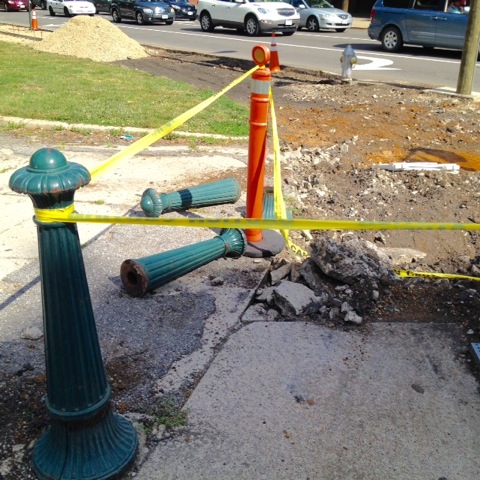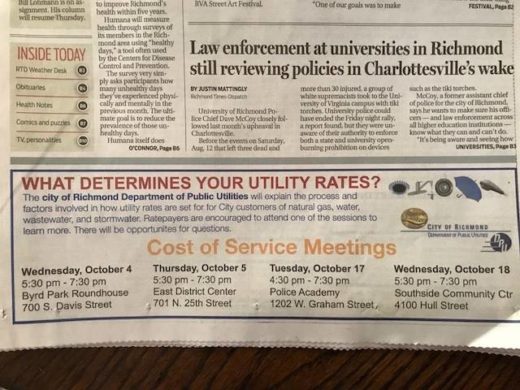Pay attention, Laurel Street neighbor Charles Pool holding school.
Dear Honorable Members of Richmond City Council,
There is an important correction printed on page A4 of today’s Richmond Times Dispatch:
“CORRECTION: The city of Richmond could generate $4.1 million in gross revenue under a revised water agreement with Chesterfield County that, if approved, would permit the county to construct a water tank and pumping station in Larus Park. The figure was misstated in a story Nov. 22 on Page B2.” [The misstated figure was given as NET revenue rather than GROSS revenue in the Nov. 22 article.]
The O&R Request accompanying Ordinance 2017-209, which would allow the county to build a 2 million gallon water tank in Larus Park, deceptively states:
“REVENUE TO CITY: $4,103,000 five year total starting in 2021.” (Please see attachment.)
Now the city administration has acknowledged to the Times Dispatch that this projected revenue to the city from the Larus Park project is GROSS not NET revenue.
The $4.1 million in projected GROSS revenue from Ordinance 2017-209 includes all of the city’s high costs for providing up to five million gallons of additional water per day (or 9.1 BILLION additional gallons of treated water over five years) to Chesterfield County. The city’s costs for providing an additional 9.1 billion gallons of treated water to the county include salaries of employees, costs for running the electrical pumps, chemicals for purifying the water, etc.
Because the city would be contractually responsible for the 4,000 feet of supply water line to the proposed facility at a cost to the city of $1.7 million, the city would actually run a NET LOSS in the five years starting in 2021.
Ordinance 2017-209 would continue for another generation the agreement where the city makes only 5% over actual costs on water volume sold to the county, which comes to only 3.5 cents per ccf (hundred cubic feet) or about $85,000 per year. Capital cost reimbursement from the project is contractually limited to reimbursement for the ACTUAL COSTS the city incurs.
Selling water volume to the county at 5% over actual costs while selling water to Richmonder’s at 500% over actual costs puts city businesses at a serious competitive disadvantage. This cheap water provided by the city is fueling the county’s potential new MEGA SITE and new Niagara water bottling plant.
Even worse: if the county unilaterally decides not to renew the lease, Ordinance 2017-209 would contractually obligate the city to pay the county for the entire $7.5 million water tank and pumping station in Larus Park, less depreciation, even if the city does not need or want the water facility.
Why should Richmond sacrifice sacred city parkland in Larus Park in order to run a NET LOSS over the next five years with the county on this water deal that puts Richmond businesses at a serious competitive disadvantage?
Honorable Members of Council, please look closely at the terms of the proposed Ordinance 2017-209 in light of the revelation in today’s Times Dispatch that the administration is deceptively projecting GROSS rather than NET revenue from the project.
Thank you very much for closely examining this issue.
Sincerely,
Charles Pool



